-
Products
-
Home & Home Office
-
E-Commerce
SSL Certificates Email and Identity Code Signing Certificate Authentication PCI Compliance PC Support Email Security Site Seals Endpoint Protection E-Commerce Bundle Includes:
EV SSL
Managed DNS
PCI Scanning
Trust Marks
Vulnerability Scanning
Purchase Protection
Customer Reviews - Small & Medium Business
- Enterprise
- Partners
- Social Media
Video Support Blogs
Importing and Using your Email or Personal Authentication certificate with Mozilla SeaMonkey Email Client (PC)
-
If you originally applied for the certificate on the same computer as your SeaMonkey installation then it should already be installed. You can skip straight to 'Signing and Encrypting'.
-
If your certificate is not already installed on the computer you are using, then please export it from the machine on which it resides using one of the browsers listed on the CPAC main page. You then need to transfer it to this computer (email it to yourself or save the certificate file to USB then copy over). You can then follow the 'import' instructions in this document.
Importing your Certificate into Mozilla SeaMonkey:
-
Open SeaMonkey and then click 'Edit' > 'Preferences'.
-
In the Preferences screen, select 'Privacy & Security' > 'Certificate' and then click the 'Manage Certificates...' button.
-
In the certificate manager interface, make sure the 'Your Certificates' tab is selected and click 'Import'.
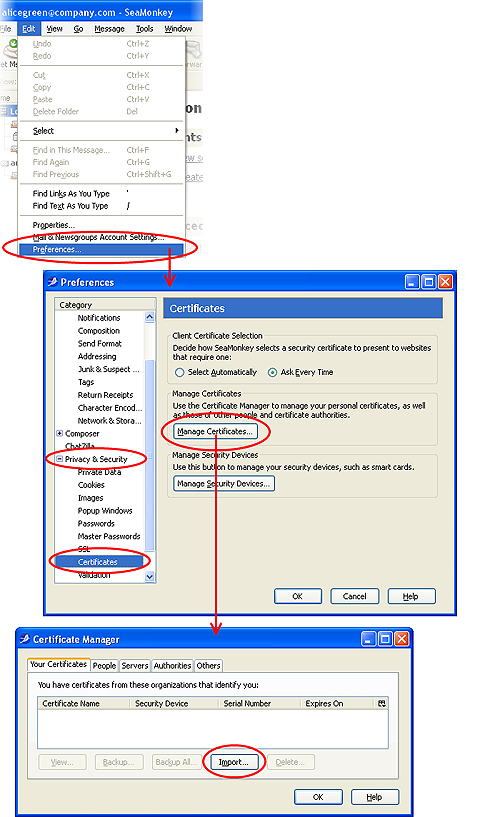
-
Navigate to the location of the PKCS12 certificate file in which your certificate is stored and enter any necessary passwords. Your certificate will be imported and you will be able to use it to digitally sign and encrypt e-mails.
-
Click OK in the Certificate Manager dialog to return to the Preferences screen.
-
Optional - select Ask me every time under When a server requests my personal certificate.
Doing this alerts you to the fact that a server has requested identity confirmation and enables you to select your Comodo Personal Authentication Certificate.
-
Click OK in the Preferences interface to return to SeaMonkey.
That's it. You have successfully imported your Comodo Personal Authentication certificate into Mozilla SeaMonkey.
Signing and Encrypting Mails
-
Signing an email ensures the recipient knows the email has come from you and informs them that it has not been modified in transit.
-
Encrypting an email ensures that only the recipient can read the email content and attachments.
Note: In order to encrypt mail, you must first have your recipient’s email certificate in your certificate store. To obtain their certificate, you need to get your contact to send you a signed email. Upon receipt of the signed mail, their certificate will be automatically imported into your certificate store and you will be able to sign/encrypt mail to that person.
Assign the certificate
-
Open SeaMonkey and select 'Edit' then 'Mail & Newsgroups Account Settings...'.
-
In the 'Mail & Newsgroups Account Settings' screen, select 'Security'.
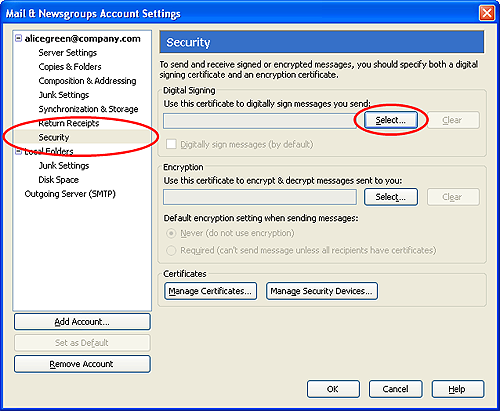
-
Click 'Select' beside the text box in the 'Digital Signing' area and select your Comodo Personal Authentication certificate from the list.
-
Click 'OK'.
-
Select the same certificate for Encryption by clicking Yes in the confirmation dialog.

-
Click OK in the Mail & Newsgroups Account Settings interface to finalize your settings.
Signing and encrypting individual mails
To sign an individual mail:
-
Compose your email and attach files as usual.
-
Click Security and choose Digitally Sign This Message.
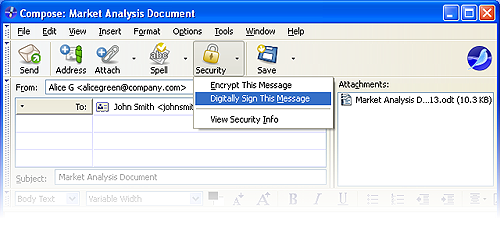
A pen icon
 will appear in the status bar, indicating that the message is digitally signed.
will appear in the status bar, indicating that the message is digitally signed. -
Click the Send button.
To encrypt each mail:
-
Compose your email and attach files as usual.
-
Ensure the recipient has a Digital Certificate and you have assigned the Certificate to their entry in your contacts area.
-
Click Security and choose Encrypt This Message.
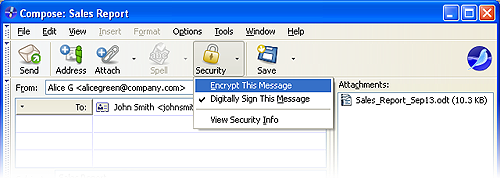
A key icon
 will be displayed in the status bar indicating that the message and the attachments are encrypted.
will be displayed in the status bar indicating that the message and the attachments are encrypted. - Click the Send button.
Signing and Encrypting all mails by default:
-
Open SeaMonkey and then click 'Edit' > 'Mail & Newsgroups Account Settings'.
-
In the 'Mail & Newsgroups Account Settings' screen, select 'Security'.
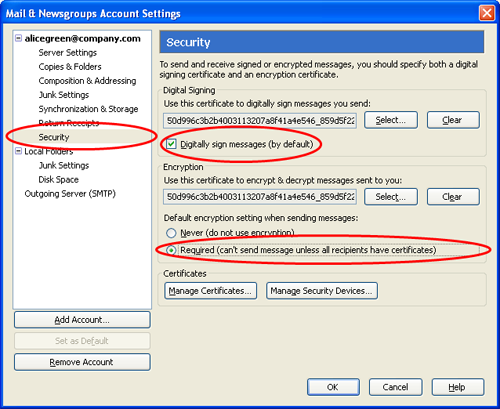
-
Select the appropriate options in the 'Digital Signing' and 'Default Encryption Settings...' areas to sign and/or encrypt your mails by default.
-
As a rule of thumb, many users choose to digitally sign by default but only encrypt when sending a message which requires confidentiality.
-
Click 'OK'.





